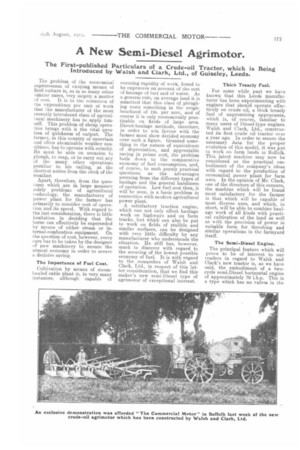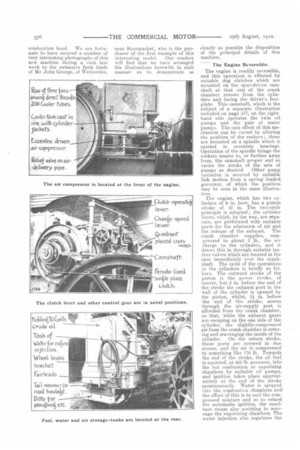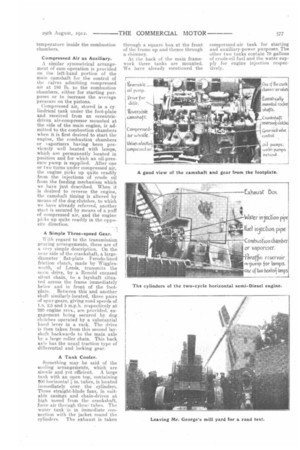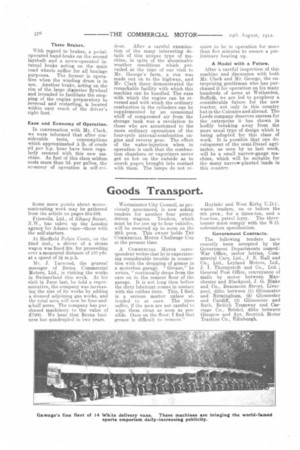A New Semi-Diesel Agrimotor.
Page 5

Page 6

Page 7

Page 8

If you've noticed an error in this article please click here to report it so we can fix it.
The First-published Particulars of a Crude-oil Tractor, which is Being Introduced by Walsh and Clark, Ltd., of Guiseley, Leeds.
The problem of the economical supersession of existing means of field culture is, as in so many other zamilar cases, very largely a matter uf cost. It is to the reduction of he expenditure per unit of work that the manufacturer of the most recently introduced class of agricultural machinery has to apply himself. This problem of cheap operation brings with it the vital question of quickness of output. The farmer, in this country of uncertain and often abominable weather conditions, has to operate with celerity. He must be able on occasion to plough, to reap, or to carry out any of the many other operations peculiar to his calling, at the shortest notice from the clerk of the weather.
Apart, therefore, -from the questions which are in large measure solely problems of agricultural t echnology, the manufacturer of power plant for the farmer has primarily to consider cost of operation and its speed. With regard to the last consideration, there is little hesitation in deciding that the horse can effectively be superseded by means of either steam or internal-combustion equipment. On the question of cost, however, every care has to be taken by the designer of pew machinery to ensure the utmost economy in order to secure a decisive saving.
The Importance of Fuel Cost.
Cultivation by means of steamhauled cable plant is, in very many instances, although capable of
ensuring rapidity of work, found to be expensive on account of the cost of hauiage of fuel and of water. As a general rule, on average land it is admitted that this class of ploughing costs something in the neighbourhood of 12s. per acre, and of course it is only economically practicable on fields of large area. Direct-haulage methods, therefore, in order to win, favour with the farmer must show decided economy over such a figure. Granted something in the nature of equivalence of depreciation, and appreciable saving in prime cost, the problem boils down to the comparative economy of fuel consumption, and, of course, to such purely practical questions as the advantages accruing from the different types of haulage and the general handiness of operation. Low fuel cost then, it will be seen, is a basic problem in connection with modern agricultural power plant.
A satisfactory traction engine, which can not only effect haulage work on highways and on farm tracks, but which can also be put to work on fields of stubble and similar surfaces, can be designed with very little difficulty by any manufacturer who understands the situation. He still has, however, much to discover with regard to the securing of the lowest possible economy of fuel. It is with regard to the researches of Walsh and Clark, Ltd., in respect of this latter consideration, that we find this maker's new semi-Diesel type of agrimotor of exceptional interest. Thick Treacly Fuel.
For some while past we have known that this Leeds manufacturer has been experimenting with engines that should operate effectively on crude oil, a thick treacly fuel of unpromising appearance, which is, of course, familiar to many users of Diesel-type engines. Walsh and Clark, Ltd., constructed its first crude oil tractor over a year ago. in order to secure the necessary data for the proper evolution of this model, it was put to work on farm lands in Suffolk. This latest machine may now be considered as the practical embodiment of the company's ideas with regard to the production of economical power plant for farm uses. In the opinion of Mr. Clark, one of the directors of this concern, the machine which will be found most satisfactory for the farmer is that which will be capable of most diverse uses, and which, in short, will be able to combine haulage work of all kinds with practical cultivation of the land as well as with the provision of power in suitable form for threshing and similar operations in the farmyard itself.
The Semi-Diesel Engine.
The principal feature which will prove to be of interest to our readers in regard to Walsh and Clark's new tractor is, as we have said, the embodiment of a twocycle semi-Diesel horizontal engine of approximately 70 i.h.p. This is a type which has no valves in the
combustion head. We are fortunate to have secured a number of very interesting photographs of this new machine during a visit last week to the extensive farm lands of Mr. John George, of Wetlierden,
near Stowmarket, who is the purchaser of the first example of this interesting model. Our readers will find that we have arranged the illustrations herewith in such manner as to demonstrate as
clearly as possible the disposition of the principal details of this machine.
The Engine Reversible.
The engine is readily reversible, and this operation is effected by suitable dog clutches which are mounted on the spur-driven camshaft at that end of the crank chamber remote from the cylinders and facing the driver's footplate. This camshaft, which is the subject of a separate illustration included on page 577, on the righthand side operates the twin oiL pumps and the pair of water pumps. The cam effect of this mechanism can be varied by altering the position of the rockers ; these are mounted on a spindle which is carried in eccentric bearings. Operation of the spindle brings the rockers nearer to, or further away from, the camshaft proper and so varies the stroke of the sets of pumps as desired. Other pump variation is secured by suitable link motion from a spring loaded governor, of which the position may be seen in the same illustration.
The engine, which has two cylinders of 9 in. bore, has a piston. stroke of 12 in. The two-cycle principle is adopted ; the cylinder liners, which, by the way, are separate are perforated with suitable pores for the admission of air and the release of the exhaust. The crank chamber supplies' compressed to about 3 lb., the air charge to the cylinders, and it draws this in through suitable leather valves which are located in the case immediately over the crankshaft. The cycle of the operations. in the cylinders is briefly as follows. The outward stroke of the piston is the power stroke, of course, but 2 in. before the end of the stroke the exhaust port in the wall of the cylinder is opened bythe piston, whilst, l in. before the end of the stroke, access through the air-supply port is afforded from the crank chamber, so that, while the exhaust gases are escaping on the one side of the cylinder, the slightly-compressed air from the crank chamber is entering and scavenging the inside of the cylinder. On the return stroke, these ports are covered in due course, and the air is compressed to something like 170 lb. Towards the end of the stroke, the oil fuel is squirted, at 450 lb. pressure, into. the hot combustion or vaporizing chambers by suitable oil pumps, and ignition takes place approximately at the end of the stroke spontaneously. Water is sprayed into the combustion chambers and the effect of this is to cool the compressed mixture and so to retard the automatic ignition, the resultant steam also assisting to scavenge the vaporizing chambers. Thewater injection also regulates th,e
temperature inside the combustion chambers.
Compressed Air as Auxiliary.
A similar symmetrical arrangement of cam operation is provided on the left-hand portion of the main camshaft for the control of the valves admitting compressed air at 180 lk to the combustion chambers, either for starting purposes or to increase the average pressure on the pistons. Compressed air, stored in a cylindrical tank under the foot-plate and received from an eccentricdriven air-compressor mounted at the side of the main engine, is admitted to the combustion chambers when it is first desired to start the engine, the combustion chambers or vaporizers having been previously well heated with lamps, which are permanently located in position and for which an oil-pressure pump is supplied. After one or two turns under compressed air, the engine picks up quite readily from the injections of crude oil from the feeding mechanism which we have just described. When it is desired to reverse the engine,
the camshaft timing is altered by means of the dog clutches, to which we have already referred, another start is secured by means of a puff of compressed air, and the engine picks up quite readily in the opposite direction.
A Simple Three-speed Gear.
With regard to the transmission gearing arrangements, these are of a very simple description. On the near side of the crankshaft, a largediameter fiat-plate Ferodo-lined friction clutch, made by Wigglesworth, of Leeds, transmits the main drive, by a RenoId encased siient chain, to a layshaft situated across the frame immediately below and in front of the footplate. Between this and another shaft similarly-located, three pairs of spur-gears, giving road speeds of 1.S, 2.5 and 5 m.p.h. respectively at 320 engine revs.; are provided, engagement being secured by dog clutches operated by a substantial hand lever in a rack. The drive is then taken from this second layshaft backwards to the main axle by a large roller chain. This hack axle has the usual traction type of differential and locking gear.
A Tank Cooler.
Something may be said of the ocroling arrangements, which are simple and yet efficient. A large tank with an open top, containing 200 horizontal in. tubes, is located immediately over the cylinders. Three straight-blade fans, in suitable casings and chain-driven at high speed from the crankshaft, force air through these tubes. The water tank -is in immediate connection with the jacket round the cylinders. The exhaust is taken through a square box at the front of the frame up and thence through a chimney.
At the back or the main framework three tanks are mounted. We have already mentioned the
compressed-air tank for starting and auxiliary-power purposes. The other two tanks contain 70 gallons of crude-oil fuel and the water supply for engine injection respectively. Three Brakes.
With regard to brakes, a pedaloperated band-brake on the second layshaft and a screw-operated internal brake acting on the main road wheels suffice for all haulage purposes. The former is operative when the winding drum is in use. Another brake, acting on the rim of the large diameter flywheel and intended to facilitate the stopping of the engine preparatory to reversal and restarting, is located within easy reach of the driver's right foot.
Ease and Economy of Operation.
In conversation with Mr. Clark, we were informed that after considerable tests., consumptions which approximated .5 lb. of crude oil per h.p. hour have been regularly secured with this new machine. As fuel of this class seldom costs more than 3d. per gallon, the economy of operation is self evi dent. After a careful examina tion of the many interesting details of this unique type of machine, in spite of the abominable weather eonditions which prevailed at the time of our visit to Mr. George's farm, a run was made out on to the highway, and Mr. Clark there demonstrated the remarkable facility with which this machine can be handled. The ease with which the engine can be reversed and with which the ordinary eombustion in the cylinders can be supplemented by an occasional whiff of compressed air from the storage tank was a revelation to those who are accustomed to the more ordinary operations of the four-cycle internal-combustion engine and reverse gear. The effect of the water-injection when in operation is such that the combustion chambers or vaporizers never get so hot on the outside as to scorch paper. brought into contact with them. The lamps do not re
quire to be in operation for more than five minutes to ensure a preliminary heating up.
A Model with a Future.
After a careful inspection of this machine and discussion with both Mr. Clark and Mr. George, the enterprising gentleman who has purchased it for operation on his many hundreds of acres at Wetherden, Suffolk, we are led to prophesy a considerable future for the new tractor, not only in this country but in the Colonies and abroad. The Leeds company deserves success for the enterprise it has shown in bodily breaking away from the more usual type of design which is being a.dopted for this class of work. It is possible that one development of the semi-Diesel agris motor, as seen by us last week, will be a small narrow-gauge machine, which will be suitable for the many narrow-planted lands in this country.






















